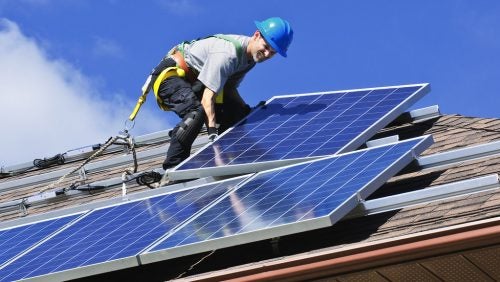So Long, Solar? The Future of Net Energy Metering in California Will Soon Be Decided
October 19, 2021 by Jaclyn Lee

Installation of a rooftop solar photovoltaic system. Image by Greens MPs via Flickr.
In September 2021, the California Public Utilities Commission (CPUC) began its highly anticipated proceeding to reevaluate the state’s net energy metering successor (NEM 2.0) tariff. Expected no later than January 2022, the decision from the national leader in solar electricity production could have far-reaching impacts on the future of customer-owned solar generation and battery storage.
What is Net Metering?
Net energy metering (NEM), or simply net metering, is an electricity billing structure that enables customers who generate their own renewable energy (“customer-generators”) to receive financial compensation for any excess generation exported to the utility power grid.[1] Under this scheme, a single bi-directional meter measures the electricity drawn from and fed back into the grid by the customer-generator.[2] At the end of a billing cycle, utility providers charge customers for their net energy consumption, generally crediting customer-generators at the retail rate for every extra kilowatt-hour of electricity exported.[3]
Background of NEM in California
Following the energy crisis of the 1970s, Congress pushed for national policies that promoted alternatives to electricity generated by centralized power plants, including customer-sited generation – a type of distributed generation.[4] To bolster customer-sited generation across the country, Congress encouraged states to adopt net metering through the Energy Policy Act of 2005.[5] Since then, the deployment of distributed generation participating in net metering has accelerated across the country.[6] Solar photovoltaic systems (“rooftop solar”), the most commonly deployed type of energy generation participating in net metering, comprised 97% of the nation’s net metering capacity in 2018.[7]
California first introduced net metering policy in 1996 to spur solar generation in the state.[8] Through Senate Bill 656, California established Net Energy Metering 1.0 (“NEM 1.0”), a program that provided full retail-rate payments for every kilowatt-hour of customer-sited solar electricity generated beyond a customer’s self-consumption.[9] Upon the looming expiration of NEM 1.0 in 2014,[10] Governor Jerry Brown signed stop-gap legislation requiring the California Public Utilities Commission (“CPUC”) to develop a successor tariff to NEM 1.0.[11]
In 2016, the CPUC adopted the landmark NEM successor tariff (“NEM 2.0”), which shifted the existing paradigm under the original NEM 1.0 program by increasing costs to the customer-generators.[12] Unlike the previous iteration, NEM 2.0 permits investor-owned utilities (“IOUs”) to impose additional charges, including a one-time interconnection fee and “non-bypassable” charges to support low-income assistance and energy efficiency programs.[13] NEM 2.0 also requires all new NEM customer-generators to sign up for time-of-use billing, which enables IOUs to adjust the value of electricity based on the time of day customers consume.[14]
The Future of NEM
According to a recently released lookback study commissioned by the CPUC, NEM 2.0 customers benefitted from the program structure while ratepayers overall faced increasing rates.[15] California’s three IOUs argue that this NEM 2.0 regime unjustly shifts costs onto customers who cannot afford solar generation, hurting lower-income and disadvantaged communities the hardest.[16] In response, solar industry advocates and many environmental groups have dismissed these claims as a further attempt by IOUs to hinder customer-owned generation.[17]
Both sides, however, agree that the next iteration of NEM must shift program benefits to the low-income and disadvantaged communities that have been overlooked.[18] Additionally, there is a consensus that an effective rooftop solar policy will require greater adoption of customer-owned battery storage and support for the electrification of heating and transport.[19]
All of these concerns will come to a head in the highly anticipated, high-stakes “NEM 3.0” proceeding, the result of which could have far-reaching policy ramifications for customer-sited solar and energy storage projects in the state and across the country.[20] With the CPUC expected to reach a decision by January 2022, the NEM 3.0 proceeding will revisit the current NEM 2.0 tariffs and address the issues raised by both sides over energy equity and the future of rooftop solar. In these next three months, the greatest challenge before the CPUC will be determining how best to support the deployment of rooftop solar and customer-owned battery storage without unduly charging all other utility customers.
[1] Net Metering, Nat’l Renewable Energy Laboratory, https://www.nrel.gov/state-local-tribal/basics-net-metering.html (last visited Oct. 7, 2021).
[2] Grid-Connected Renewable Energy Systems, U.S. Dep’t of Energy, https://www.energy.gov/energysaver/grid-connected-renewable-energy-systems (last visited Oct. 7, 2021).
[3] Id.
[4] Ashley J. Lawson, Cong. Rsch. Serv., R46010 Net Metering: In Brief 1 (2019).
[5] Id.
[6] Id. As of August 2021, thirty-nine states plus D.C. and the U.S. territories have mandatory net metering rules in place. Detailed Summary Maps, North Carolina Clean Energy Center, https://www.dsireusa.org/resources/detailed-summary-maps/.
[7] Lawson, supra note 4.
[8] See S.B. 656, 1995 Leg., 369th Sess. (Cal. 1995).
[9] Id.
[10] See Calculation of the Net Energy Metering Cap, 12-05-036 (Cal. Pub. Util. Comm’n May 24, 2012).
[11] Assemb. B. 327, 2013-2014 Reg. Sess., ch. 611 (Cal. 2013).
[12]See Decision Adopting Successor to Net Energy Metering Tariff,16-01-044 (Cal. Pub. Utils. Comm’n Feb. 5, 2016).
[13] Id.
[14] Id.
[15] Verdant Associates, LLC, Net-Energy Metering 2.0 Lookback, , 1 (2021)
[16] See Affordable Clean Energy for All, https://fixthecostshift.com (last visited Oct. 7, 2021).
[17] See Jeff St. John, The battle over net metering 3.0 in California: Energy equity and the future of rooftop solar, Canary Media (Apr. 12, 2021), https://www.canarymedia.com/articles/solar/californias-net-metering-3-0-battle-energy-equity-and-the-future-of-rooftop-solar.
[18] Id.
[19] Id.
[20] See Ben Zientara, Big changes on the horizon for California net metering in 2022, Solar Reviews (Aug. 25, 2021), https://www.solarreviews.com/blog/big-changes-for-california-net-metering.

